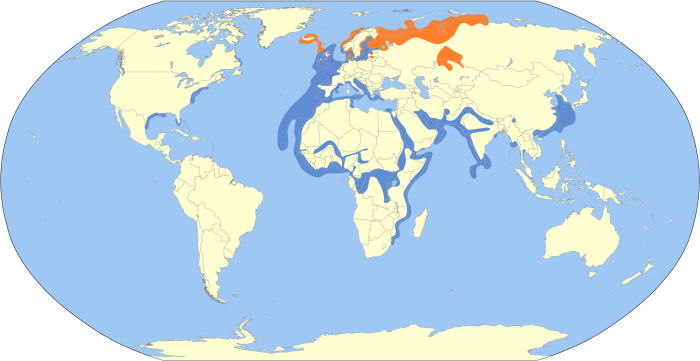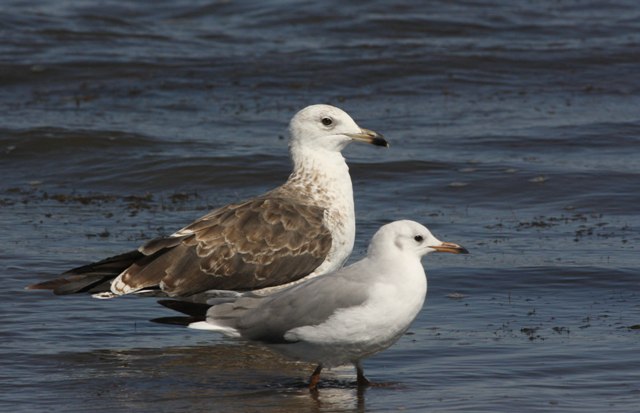Identification
In the interior of South Africa, almost any gull which at first glance looks like a Kelp Gull (white head and body, black back and wings) is most likely a Lesser Black-backed Gull!
Adults have pale yellow eyes and yellow legs, but Kelp Gulls have dark eyes and dull greenish grey legs. There are also subtle differences in bill shape; the Kelp Gull has a rather stubby bill.

When standing, the wings of the Lesser Black-backed Gull project further beyond the end of tail than in Kelp Gull. Overall, this helps give it a sleeker appearance than Kelp Gull.

Here is a photograph with both species, an adult Lesser Black-backed Gull in the middle, and a nearly adult Kelp Gull on the right:

However, most of the Lesser Black-backed Gulls in South Africa are sub-adults, and are quite tricky to separate from sub-adult Kelp Gulls.
First-year Lesser Black-backed Gulls have a dark eye; it becomes yellowish by the second year. Full adult plumage takes about four years to develop.
Habitat
Inland, Lesser Black-backed Gulls occur mainly on large wetlands, such as pans, flood plains and large dams.

On the coastline, they are mostly on (or near) large intertidal wetlands.

Distribution
The distribution map shows that this gull is a vagrant. There are only handfuls of bird atlas records, and it took 16 years from 2007 to 2023 make them! You need to focus to find them on the map, and you need to be lucky to find them while you are birding!

This is a rare species in South Africa, so the pentads in which it occurs are mostly shaded yellow. They are scattered across the interior (at large wetlands), and along the coastline of KwaZulu-Natal (e.g. St Lucia, Durban) and the Eastern Cape (e.g. Algoa Bay, Kromme River Estuary).


The 18 BirdPix records for Lesser Black-backed Gull in the Virtual Museum are from the Sudan (on the Nile River at Khartoum, Zambia, large freshwater wetlands in the interior of South Africa, and at large intertidal wetlands along the coastline of KwaZulu-Natal and the Eastern Cape.

On this map of the global distribution, the breeding area is shaded orange, and the main non-breeding areas are shaded blue. It breeds in northern Eurasia and migrates southwards after breeding. Most birds stay in the northern hemisphere, and only small numbers move as far south as southern Africa. This map suggests that the southernmost part of the regular non-breeding distribution is along the east coast of Africa. North of about Durban, the distribution of Kelp Gulls starts to fade out, with the northernmost records ending at Maputo Bay in southern Mozambique. Any large gull in northern KwaZulu-Natal needs to be examined carefully!
Most sightings are between October and March, but some birds stay here throughout the year. Records are sporadic in both space and time.
This species was not included in the first two editions of Roberts Birds of Southern Africa, published in 1940 and 1957. It was admitted for the first time in the third edition in 1970! Even then it said: “Recorded from the Zambesi River and the Caprivi”. The fourth edition in 1978 says the same, and here is the distribution map for the Kelp Gull in the 1978 edition of Roberts:

It is quite a surprise that it took so long to grasp that all the arrows to wetlands in the interior were actually not Kelp Gulls at all. In 1952, 26 years earlier, there is an extraordinarily politely worded paper in the journal Ostrich (25: 123–124) which asks the question: “Does the European Lesser Black-backed Gull migrate to South Africa?” It gently points out that sight records, claimed to be Kelp Gulls, on the highveld at Springs (Gauteng) in 1947 and at Barberspan (North West Province) in 1951 and 1952, were “a surprise”. “It seems,” says RM Harwin, “that some sorting-out of these records is necessary.” He showed, on balance of probabilities, that a Kelp Gull reaching the highveld from the coast was less likely than a Lesser Black-backed Gull reaching this area from the north. It took a long time to do that re-assessment. It was finally conceded in Roberts 5 in 1985 that RM Harwin had been right all along, and that the “Kelp Gulls” in the interior had been misidentified!
What is clear is that the frequency of records of the migrant gull in the interior have increased. This is most likely not only because there are more birders, but is genuinely attributable to the proliferation of large dams and other artificial wetlands across the interior of southern Africa.
More common names: Kleinswartrugmeeuw (Afrikaans), Goéland brun (French), Heringsmöwe (German), Gaivota-d’asa-escura (Portuguese), Gaviota (Spanish), Kleine mantelmeeuw, Baltische mantelmeeuw (Dutch)
Photographic acknowledgements: The photographs in this identification guide are from the BDI Virtual Museum. The photographers continue to own the copyright on these images.
Recommended citation format: Underhill LG 2023. Lesser Black-backed Gull Larus fuscus. Biodiversity and Development Institute. Available online at https://thebdi.org/2023/04/06/lesser-black-backed-gull-larus-fuscus/






Hi Les, great to hear from you again.For years I battled to get LBB Gull on my list. One was reported from East London but it eluded me. Eventually I was atlassing the Kromme River estuary and amongst a Kelp Gull roost I noticed one was different.
They appear once in a while but I wouldn’t say they are common given how long it took me get it on my list
Best wishes,
Alan.